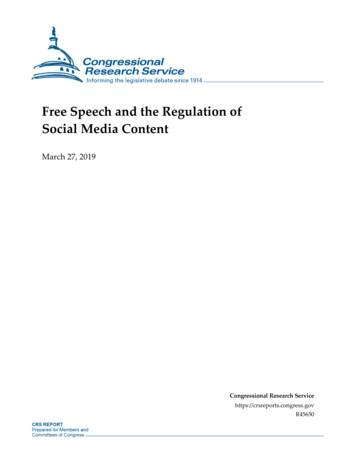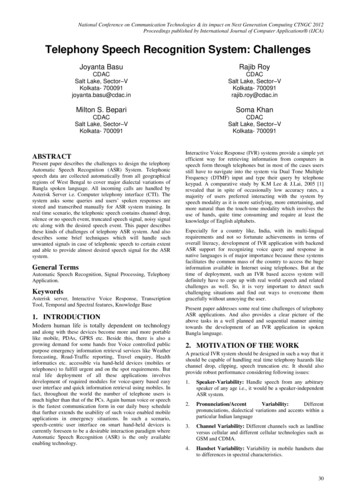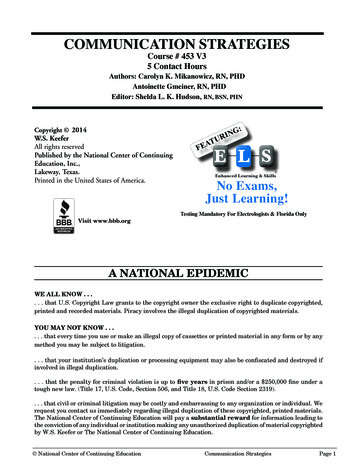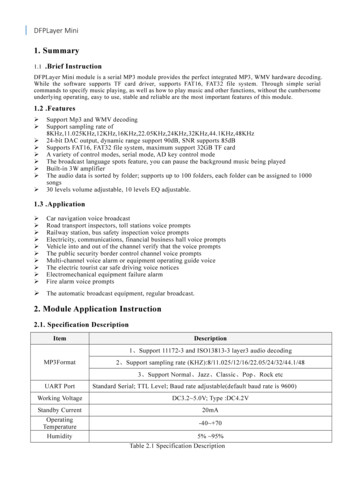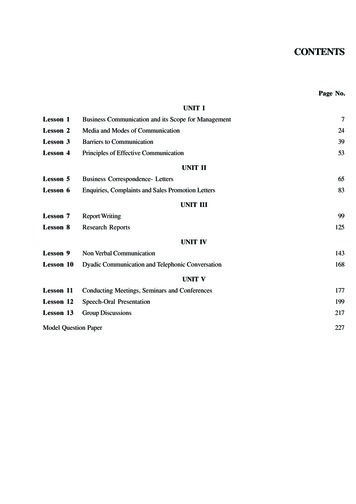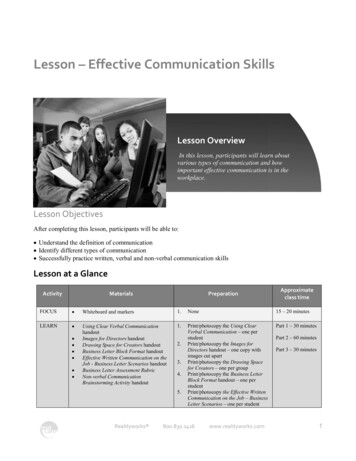
Transcription
Unit 1 – Interpersonal CommunicationChapter 1 . CommunicationChapter 2 . Verbal CommunicationChapter 3 . Nonverbal CommunicationChapter 4 . Interpersonal Communication OverviewUnit 2 – Mass CommunicationChapter 5 . Mass CommunicationUnit 3 – Public SpeakingChapter 6 . The Basics of Public SpeakingChapter 7 . Audience Analysis and ListeningChapter8 . Developing Topics for Your SpeechChapter 9 . Supporting Your Speech IdeasChapter 10 . Introductions and ConclusionsChapter 11 . Visual AidsUnit 4 – Business SpeakingChapter 12 . Interviewing LICENSED CONTENT, SHARED PREVIOUSLYMost content in these units from:o Paynton, S.T., Hahn, L.K. (201?). Survey of Communication Study. Humbolt State University. Retrieved fromhttps://en.wikibooks.org/wiki/Survey of Communication Study. CC By-SA: Attribution-ShareAlike2
o Tucker, Barbara and Barton, Kristin, "Exploring Public Speaking: 2nd Edition" (2016). Communication OpenTextbooks. 1. s/1o Fetch, F. (2014). The Art of Interview Skills. Published by bookbon.com ISBN 978-87-403-0716-0Additions and edits C. Vleugels.3
Chapter 1Study of CommunicationCHAPTER OBJECTIVESBy the end of this chapter, you will be able to: Explain Communication Study. Define Communication. Explain the linear and transactional models of communication. Discuss the benefits of studying Communication.You are probably reading this book because you are taking an introductory Communication course at your college oruniversity. Many colleges and universities around the country require students to take some type of communicationcourse in order to graduate. Introductory Communication classes include courses on public speaking, interpersonalcommunication, or a class that combines both. While these are some of the most common introductoryCommunication courses, many Communication departments are now offering an introductory course that explainswhat Communication is, how it is studied as an academic field, and what areas of specialization make up the field ofCommunication. In other words, these are survey courses similar to courses such as Introduction to Sociology orIntroduction to Psychology. Our goal in this text is to introduce you to the field of Communication as an academicdiscipline of study.What is Communication Study?Bruce Smith, Harold Lasswell, and Ralph D. Casey provided a good and simple answer to the question, “What isCommunication study?” They state that, communication study is an academic field whose primary focus is “whosays what, through what channels (media) of communication, to whom, [and] what will be the results.”Egyptian antiquities in the Brooklyn Museum4
Although they gave this explanation almost 70 years ago, to this day it succinctly describes the focus ofCommunication scholars and professionals. As professors and students of Communication, we extensively examinethe various forms and outcomes of human communication. On its website, the National CommunicationAssociation (NCA), states that communication study “focuses on how people use messages to generatemeanings within and across various contexts, cultures, channels and media. The discipline promotes the effectiveand ethical practice of human communication.” They go on to say, “Communication is a diverse discipline whichincludes inquiry by social scientists, humanists, and critical and cultural studies scholars.” Now, if people ask youwhat you’re studying in a Communication class, you have an answer!In this course we will use Smith, Lasswell, and Casey’s definition to guide how we discuss the content in this book.Now that you know how to define communication study, are you able to develop a simple definition ofcommunication? Try to write a one-sentence definition of communication!We’re guessing it’s more difficult than you think. Don’t be discouraged. For decades communication professionalshave had difficulty coming to any consensus about how to define the term communication (Hovland; Morris; Nilsen;Sapir; Schramm; Stevens). Even today, there is no single agreed-upon definition of communication. In 1970 and1984 Frank Dance looked at 126 published definitions of communication in our literature and said that the task oftrying to develop a single definition of communication that everyone likes is like trying to nail Jello to a wall. Thirtyyears later, defining communication still feels like nailing Jello to a wall.AristotleAristotle said, “Rhetoric falls into three divisions, determined by the three classes of listeners to speeches. For of thethree elements in speech-making — speaker, subject, and person addressed — it is the last one, the hearer, thatdetermines the speech’s end and object.”For Aristotle it was the “to whom” that determined if communication occurred and how effective it was. Aristotle, in hisstudy of “who says what, through what channels, to whom, and what will be the results” focused on persuasion andits effect on the audience. Aristotle thought it was extremely important to focus on the audience in communicationexchanges.5
What is interesting is that when we think of communication we are often, “more concerned about ourselves as thecommunication’s source, about our message, and even the channel we are going to use. Too often, the listener,viewer, or reader fails to get any consideration at all (Lee, 2008).For the purpose of this text we define communication as the process of using symbols to exchange meaning.Let’s examine two models of communication to help you further grasp this definition. Shannon and Weaver proposeda Mathematical Model of Communication (often called the Linear Model) that serves as a basic model ofcommunication. This model suggests that communication is simply the transmission of a message from one sourceto another. Watching YouTube videos serves as an example of this. You act as the receiver when you watch videos,receiving messages from the source (the YouTube video). To better understand this, let’s break down each part ofthis model.The Linear Model of CommunicationThe Linear Model of Communication is a model that suggests communication moves only in one direction.The Sender encodes a Message, then uses a certain Channel (verbal/nonverbal communication) to send it toa Receiver who decodes (interprets) the message. Noise is anything that interferes with, or changes, the originalencoded message.Linear Model of Communication A sender is someone who encodes and sends a message to a receiver through a particular channel. Thesender is the initiator of communication. For example, when you text a friend, ask a teacher a question, orwave to someone you are the sender of a message. A receiver is the recipient of a message. Receivers must decode (interpret) messages in ways that aremeaningful for them. For example, if you see your friend make eye contact, smile, wave, and say “hello” asyou pass, you are receiving a message intended for you. When this happens you must decode the verbaland nonverbal communication in ways that are meaningful to you.6
A message is the particular meaning or content the sender wishes the receiver to understand. The messagecan be intentional or unintentional, written or spoken, verbal or nonverbal, or any combination of these. Forexample, as you walk across campus you may see a friend walking toward you. When you make eye contact,wave, smile, and say “hello,” you are offering a message that is intentional, spoken, verbal and nonverbal. A channel is the method a sender uses to send a message to a receiver. The most common channelshumans use are verbal and nonverbal communication which we will discuss in detail in later in the book.Verbal communication relies on language and includes speaking, writing, and sign language. Nonverbalcommunication includes gestures, facial expressions, paralanguage, and touch. We also use communicationchannels that are mediated (such as television or the computer) which may utilize both verbal and nonverbalcommunication. Using the greeting example above, the channels of communication include both verbal andnonverbal communication. Noise is anything that interferes with the sending or receiving of a message. Noise is external (a jackhammer outside your apartment window or loud music in a nightclub), and internal (physical pain,psychological stress, or nervousness about an upcoming test). External and internal noise make encodingand decoding messages more difficult. Using our ongoing example, if you are on your way to lunch andlistening to music on your phone when your friend greets you, you may not hear your friend say “hello,” andyou may not wish to chat because you are hungry. In this case, both internal and external noise influencedthe communication exchange. Noise is in every communication context, and therefore, NO message isreceived exactly as it is transmitted by a sender because noise distorts it in one way or another.A major criticism of the Linear Model of Communication is that it suggests communication only occurs in onedirection. It also does not show how context, or our personal experiences, impact communication. Television servesas a good example of the linear model. Have you ever talked back to your television while you were watching it?Maybe you were watching a sporting event or a dramatic show and you talked at the people in the television. Didthey respond to you? We’re sure they did not. Television works in one direction. No matter how much you talk to thetelevision it will not respond to you. Now apply this idea to the communication in your relationships. It seemsridiculous to think that this is how we would communicate with each other on a regular basis. This example shows thelimits of the linear model for understanding communication, particularly human to human communication.Given the limitations of the Linear Model, Barnlund adapted the model to more fully represent what occurs in mosthuman communication exchanges. The Transactional Model demonstrates that communication participants act assenders AND receivers simultaneously, creating reality through their interactions. Communication is not a simpleone-way transmission of a message: The personal filters and experiences of the participants impact eachcommunication exchange. The Transactional Model demonstrates that we are simultaneously senders andreceivers, and that noise and personal filters always influence the outcomes of every communication exchange.Transactional Model of Communication7
The Transactional Model of CommunicationThe Transactional Model of Communication adds to the Linear Model by suggesting that both parties in acommunication exchange act as both sender and receiver simultaneously, encoding and decoding messages to andfrom each other at the same time.This model takes into account your previous communication. So, while it might be common to hear that an argumentor previous conversations was “in the past”, communication never just disappears. All of your previous interactionsare part of each new interaction.While these models are overly simplistic representations of communication, they illustrate some of the complexities ofdefining and studying communication. Going back to Smith, Lasswell, and Casey, as Communication scholars wemay choose to focus on one, all, or a combination of the following: senders of communication, receivers ofcommunication, channels of communication, messages, noise, context, and/or the outcome of communication. Wehope you recognize that studying communication is simultaneously detail-oriented (looking at small parts of humancommunication), and far-reaching (examining a broad range of communication exchanges).The Study of Communication References for This ChapterAdams, Susan. “The 10 Skills Employers Most Want In 20-Something Employees” Forbes. 11 Oct. 2013. Web. 15Dec. 2014.Barnlund, Dean. “A Transactional Model of Communication.” Foundations of Communication Theory. New York:Harper & Row, 1970. Print.Dance, Frank E. X. “The ‘Concept’ of Communication.” Journal of Communication 20.2 (1970): 201-210. WileyOnline Library. Web. 16 Dec. 2014.—. “What Is Communication?: Nailing Jello to the Wall.” Association for Communication Administration Bulletin 48.4(1984): 4-7. Print.Dunleavy, Katie Neary et al. “Daughters’ Perceptions of Communication with Their Fathers: The Role of SkillSimilarity and Co-Orientation in Relationship Satisfaction.” Communication Studies 62.5 (2011): 581-596.EBSCOhost. Web. 16 Dec. 2014.Hovland, Carl I. “Social Communication.” Proceedings of the American Philosophical Society 92.5 (1948): 371-375.Print.Koenig Kellas, Jody, and Elizabeth A. Suter. “Accounting for Lesbian-Headed Families: Lesbian Mothers’ Responsesto Discursive Challenges.”Communication Monographs 79.4 (2012): 475-498. EBSCOhost. Web. 16 Dec. 2014.Lee, Dick. Developing Effective Communications. University of Missouri Extension. 31 March 2008. Web. Dec. 2014.Miller-Day, Michelle, and Josephine W. Lee. “Communicating Disappointment: The Viewpoint of Sons andDaughters.” Journal of Family Communication 1.2 (2001): 111-131. Taylor and Francis NEJM. Web. 16 Dec.2014.8
Morris, Charles. Signs, Language and Behavior. xii. Oxford, England: Prentice-Hall, 1946. Print.NCA. What is Communication?. National Communication Association, 2014. Web. 15 December 2014.Nilsen, Thomas R. “On Defining Communication.” The Speech Teacher 6.1 (1957): 10-17. Taylor andFrancis NEJM. Web. 16 Dec. 2014.Panek, Elliot. “Left to Their Own Devices: College Students’ ‘Guilty Pleasure’ Media Use and TimeManagement.” Communication Research 41.4 (2014): 561-577. EBSCOhost. Web.Sapir, Edward. “Communication.” Encylopedia of the Social Sciences. New York: Macmillan Company, 1933. Print.Schramm, William. Communication in Modern Society: Fifteen Studies of the Mass Media Prepared for the Universityof Illinois Institution of Communication Research. Urbana, IL: University of Illinois Press. Print.Shannon, Claude, and Weaver, Warren. A Mathematical Model of Communication. Urbana, IL: University of IllinoisPress, 1949. Print.Smith, Bruce Lannes, Harold Dwight Lasswell, and Ralph Droz Casey. Propaganda, Communication, and PublicOpinion: A Comprehensive Reference Guide. Princeton University press, 1946. Print.Soukup, Paul A. “Looking At, With, and through YouTube.” Communication Research Trends 33.3 (2014): 3-34.Print.Stevens, Sam. “Introduction: A Definition of Communication.” The Journal of the Acoustical Society of America 22.6(1950): 689-690. scitation.aip.org. Web. 16 Dec. 2014.Tyme, Justin. Organizational Leadership: 73 Tips from Aristotle. Amazon, 2012. Kindle.Wise, Megan, and Dariela Rodriguez. “Detecting Deceptive Communication Through Computer-MediatedTechnology: Applying Interpersonal Deception Theory to Texting Behavior.” Communication ResearchReports 30.4 (2013): 342-346. EBSCOhost. Web. 16 Dec. 2014.9
Chapter 2Verbal CommunicationCHAPTER OBJECTIVESAfter reading this chapter you should be able to: Define verbal communication and explain its main characteristics. Understand the three qualities of symbols. Describe the rules governing verbal communication. Explain the differences between written and spoken communication. Describe the functions of verbal communication.“Consciousness can’t evolve any faster than language” – Terence McKennaImagine for a moment that you have no language with which to communicate. It’s hard to imagine isn’t it? It’sprobably even harder to imagine that with all of the advancements we have at our disposal today, there are people inour world who actually do not have, or cannot use, language to communicate.Just a few decades ago, the Nicaraguan government started bringing deaf children together from all over the countryin an attempt to educate them. These children had spent their lives in remote places and had no contact with otherdeaf people. They had never learned a language and could not understand their teachers or each other. Likewise,their teachers could not understand them. Shortly after bringing these students together, the teachers noticed that thestudents communicated with each other in what appeared to be an organized fashion: they had literally broughttogether the individual gestures they used at home and composed them into a new language. Although the teachersstill did not understand what the kids were saying, they were astonished at what they were witnessing—the birth of anew language in the late 20th century! This was an unprecedented discovery.In 1986 American linguist Judy Kegl went to Nicaragua to find out what she could learn from these children withoutlanguage. She contends that our brains are open to language until the age of 12 or 13, and then language becomesdifficult to learn. She quickly discovered approximately 300 people in Nicaragua who did not have language and10
says, “They are invaluable to research – among the only people on Earth who can provide clues to the beginnings ofhuman communication.” To access the full transcript, view the following link: CBS News: Birth of a Language.Adrien Perez, one of the early deaf students who formed this new language (referred to as Nicaraguan SignLanguage), says that without verbal communication, “You can’t express your feelings. Your thoughts may be therebut you can’t get them out. And you can’t get new thoughts in.” As one of the few people on earth who hasexperienced life with and without verbal communication, his comments speak to the heart of communication: it is theessence of who we are and how we understand our world. We use it to form our identities, initiate and maintainrelationships, express our needs and wants, construct and shape world-views, and achieve personal goals (Pelley).In this chapter, we want to provide and explain our definition of verbal communication, highlight the differencesbetween written and spoken verbal communication, and demonstrate how verbal communication functions in ourlives.Defining Verbal CommunicationWhen people ponder the word communication, they often think about the act of talking. We rely on verbalcommunication to exchange messages with one another and develop as individuals. The term verbal communicationoften evokes the idea of spoken communication, but written communication is also part of verbal communication.Reading this book you are decoding the authors’ written verbal communication in order to learn more aboutcommunication. Let’s explore the various components of our definition of verbal communication and examine how itfunctions in our lives.Verbal communication is about language, both written and spoken. In general, verbal communication refers to ouruse of words while nonverbal communication refers to communication that occurs through means other than words,such as body language, gestures, and silence. Both verbal and nonverbal communication can be spoken and written.Many people mistakenly assume that verbal communication refers only to spoken communication. However, you willlearn that this is not the case. Let’s say you tell a friend a joke and he or she laughs in response. Is the laughterverbal or nonverbal communication? Why? As laughter is not a word we would consider this vocal act as a form ofnonverbal communication. For simplification, the box below highlights the kinds of communication that fall into thevarious categories. You can find many definitions of verbal communication in our literature, but for this text, wedefine Verbal Communication as an agreed-upon and rule-governed system of symbols used to sharemeaning. Let’s examine each component of this definition in detail.Verbal CommunicationNonverbal CommunicationOralSpoken LanguageLaughing, Crying, Coughing, etc.NonverbalWritten Language/Sign LanguageGestures, Body Language, etc.A System of SymbolsSymbols are arbitrary representations of thoughts, ideas, emotions, objects, or actions used to encode and decodemeaning (Nelson & Kessler Shaw). Symbols stand for, or represent, something else. For example, there is nothinginherent about calling a cat a cat.Rather, English speakers have agreed that these symbols (words), whose components (letters) are used in aparticular order each time, stand for both the actual object, as well as our interpretation of that object. This idea isillustrated by C. K. Ogden and I. A. Richard’s triangle of meaning. The word “cat” is not the actual cat. Nor does it11
have any direct connection to an actual cat. Instead, it is a symbolic representation of our idea of a cat, as indicatedby the line going from the word “cat” to the speaker’s idea of “cat” to the actual object.Symbols have three distinct qualities: they are arbitrary, ambiguous, and abstract. Notice that the picture of the cat onthe left side of the triangle more closely represents a real cat than the word “cat.” However, we do not use pictures aslanguage, or verbal communication. Instead, we use words to represent our ideas. This example demonstrates ouragreement that the word “cat” represents or stands for a real cat AND our idea of a cat. The symbols we useare arbitrary and have no direct relationship to the objects or ideas they represent. We generally considercommunication successful when we reach agreement on the meanings of the symbols we use.Not only are symbols arbitrary, they are ambiguous — that is, they have several possible meanings. Imagine yourfriend tells you she has an apple on her desk. Is she referring to a piece of fruit or her computer? If a friend says thata person he met is cool, does he mean that person is cold or awesome? The meanings of symbols change over timedue to changes in social norms, values, and advances in technology. You might be asking, “If symbols can havemultiple meanings then how do we communicate and understand one another?” We are able to communicatebecause there are a finite number of possible meanings for our symbols, a range of meanings which the members ofa given language system agree upon. Without an agreed-upon system of symbols, we could share relatively littlemeaning with one another.A simple example of ambiguity can be represented by one of your classmates asking a simple question to theteacher during a lecture where she is showing PowerPoint slides: “can you go to the last slide please?” The teacheris half way through the presentation. Is the student asking if the teacher can go back to the previous slide? Or does12
the student really want the lecture to be over with and is insisting that the teacher jump to the final slide of thepresentation? Chances are the student missed a point on the previous slide and would like to see it again to quicklytake notes. However, suspense may have overtaken the student and they may have a desire to see the final slide.Even a simple word like “last” can be ambiguous and open to more than one interpretation.The verbal symbols we use are also abstract, meaning that, words are not material or physical. A certain level ofabstraction is inherent in the fact that symbols can only represent objects and ideas. This abstraction allows us to usea phrase like “the public” in a broad way to mean all the people in the United States rather than having to distinguishamong all the diverse groups that make up the U.S. population. Similarly, in J.K. Rowling’s Harry Potter book series,wizards and witches call the non-magical population on earth “muggles” rather than having to define all the separatecultures of muggles. Abstraction is helpful when you want to communicate complex concepts in a simple way.However, the more abstract the language, the greater potential there is for confusion.Rule-GovernedVerbal communication is rule-governed. We must follow agreed-upon rules to make sense of the symbols we share.Let’s take another look at our example of the word cat. What would happen if there were no rules for using thesymbols (letters) that make up this word? If placing these symbols in a proper order was not important, then cta, tac,tca, act, or atc could all mean cat. Even worse, what if you could use any three letters to refer to cat? Or still worse,what if there were no rules and anything could represent cat? Clearly, it’s important that we have rules to govern ourverbal communication. There are four general rules for verbal communication, involving the sounds, meaning,arrangement, and use of symbols.SOUNDS AND LETTERS: A POEM FOR ENGLISH STUDENTSWhen in English class we speak,Why is break not rhymed with freak?Will you tell me why it’s trueThat we say sew, but also few?When a poet writes a verseWhy is horse not rhymed with worse?Beard sounds not the same as heardLord sounds not the same as wordCow is cow, but low is lowShoe is never rhymed with toe.Think of nose and dose and loseThink of goose, but then of choose.Confuse not comb with tomb or bomb,Doll with roll, or home with some.We have blood and food and good.Mould is not pronounced like could.There’s pay and say, but paid and said.“I will read”, but “I have read”.Why say done, but gone and lone –Is there any reason known?To summarise, it seems to meSounds and letters disagree.Taken ay.htm13
Phonology is the study of speech sounds. The pronunciation of the word cat comes from the rules governinghow letters sound, especially in relation to one another. The context in which words are spoken may provideanswers for how they should be pronounced. When we don’t follow phonological rules, confusion results. Oneway to understand and apply phonological rules is to use syntactic and pragmatic rules to clarify phonologicalrules. Semantic rules help us understand the difference in meaning between the word cat and the word dog.Instead of each of these words meaning any four-legged domestic pet, we use each word to specify whatfour-legged domestic pet we are talking about. You’ve probably used these words to say things like, “I’m a catperson” or “I’m a dog person.” Each of these statements provides insight into what the sender is trying tocommunicate. “A Poem for English Students,” not only illustrates the idea of phonology, but also semantics.Even though many of the words are spelled the same, their meanings vary depending on how they arepronounced and in what context they are used. We attach meanings to words; meanings are not inherent inwords themselves. As you’ve been reading, words (symbols) are arbitrary and attain meaning only whenpeople give them meaning. While we can always look to a dictionary to find a standardized definition of aword, or its denotative meaning, meanings do not always follow standard, agreed-upon definitions whenused in various contexts. For example, think of the word “sick.” The denotative definition of the word is ill orunwell. However, connotative meanings, the meanings we assign based on our experiences and beliefs,are quite varied. Sick can have a connotative meaning that describes something as good or awesome asopposed to its literal meaning of illness, which usually has a negative association. The denotative andconnotative definitions of “sick” are in total contrast of one another which can cause confusion. Think aboutan instance where a student is asked by their parent about a friend at school. The student replies that thefriend is “sick.” The parent then asks about the new teacher at school and the student describes the teacheras “sick” as well. The parent must now ask for clarification as they do not know if the teacher is in bad health,or is an excellent teacher, and if the friend of their child is ill or awesome. Syntactics is the study of language structure and symbolic arrangement. Syntactics focuses on the rules weuse to combine words into meaningful sentences and statements. We speak and write according to agreedupon syntactic rules to keep meaning coherent and understandable. Think about this sentence: “The pink andpurple elephant flapped its wings and flew out the window.” While the content of this sentence is fictitious andunreal, you can understand and visualize it because it follows syntactic rules for language structure. Pragmatics is the study of how people actually use verbal communication. For example, as a student youprobably speak more formally to your professors than to your peers. It’s likely that you make different wordchoices when you speak to your parents than you do when you speak to your friends. Think of the words“bowel movements,” “poop,” “crap,” and “shit.” While all of these words have essentially the same denotativemeaning, people make choices based on context and audience regarding which word they feel comfortableusing. These differences illustrate the pragmatics of our verbal communication. Even though you use agreedupon symbolic systems and follow phonological, syntactic, and semantic rules, you apply these rulesdifferently in different contexts. Each communication context has different rules for “appropriate”communication. We are trained from a young age to communicate “appropriately” in different social contexts.It is only through an agreed-upon and rule-governed system of symbols that we can exchange verbal communicationin an effective manner. Without agreement, rules, and symbols, verbal communication would not work. The reality is,after we learn language in school, we don’t spend much time consciously thinking about all of these rules, we simplyuse them. However, rules keep our verbal communication structured in ways that make it useful for us tocommunicate more effectively.14
ListeningBecause Verbal Communication is the starting point and foundation of our survey of communication, we will beginwith the fundamental counterpoint to verbal communication; the practice of listening.SUMMARYListen first and acknowledge what you hear, even if you don’t agree with it, before expressing your experience orpoint of view. In order to get more of your conversation partner’s attention in tense situations, pay atte
4 Chapter 1 Study of Communication CHAPTER OBJECTIVES By the end of this chapter, you will be able to: Explain Communication Study. Define Communication. Explain the linear and transactional models of communication. Discuss the benefits of studying Communication. You are probably reading this book because you are taking an introductory Communication course at


